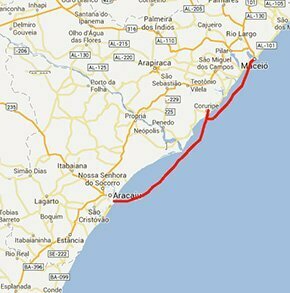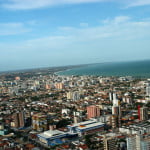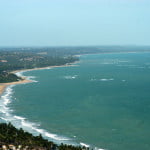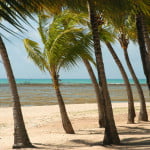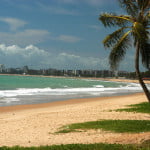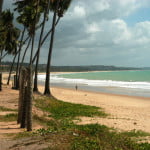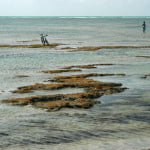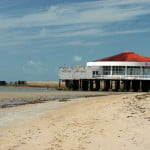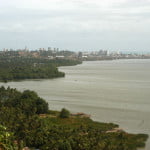Tuesday, 29 – 11 – 2005.
I woke up at 2 a.m. when Alonso was starting the boat motor. After the first battery twist I got up. We had to sail 40 miles to arrive at Portal do Coruripe, the first stop of this part of the journey.
The wind changed again. Now we have the north-east wind and it won’t change until the end of the summer. So much the better. There is nothing better than sailing helped by the wind and the current, just for a change. The night was dark, no moon, and just a few stars. These two days, it has rained lightly at dawn. In Maceio, we were anchored in front of the Federação de Vela (Sail Federation) next to the port platform. Funny. This seems to be the only uninteresting beach of this state. It is really ugly. The worst thing is the turbid water, the unpleasant smell and the bad condition of the water. It is a pity. There is too much pollution here. It’s been a long time since I last saw something like this. Every time we had to leave or go back to the boat, we inevitably plunged our feet into the water. It was kind of disgusting and I noticed my mates reacted the same way. Alagoas is marvelous in terms of natural beauty, but it is very badly treated. Ibama’s people are even more ineffective here than in the other states we visited. I will tell you why later. We sailed about 10 miles outwards before pointing the prow towards the right direction. Then we adapted the Endless Sea sails, the mainsail and the genoa for a north-east wind of 18, 20 knots. We had wonderful sailing to Coruripe where we arrived this morning.
We had to be very careful when we were entering because Alagoas’ coast is surrounded by a sort of continuous strip of sandstone reefs, sometimes there are a few breaches. When you go beyond this natural barrier, the sea level is low which explains the presence of so many corals. To make things worse, when you approach the beach, usually you see coral reefs glued to the sand. This means that to enter in these bays, you have to sail between two barriers, always very low. That’s exactly what a sailboat shouldn’t do seeing that our draught is 1 meter and 80 centimeters deep… But since it is for a TV program, let’s do it!
Fortunately, during our arrival we were helped by a fishing boat that guided us zigzagging between the reefs. The boat was anchored at 10 a.m.
Gosh, we have hurried during these trips. We arrived on Thursday the 24th, at lunch time. We have already interviewed a few teachers from Alagoas’ Federal University as well as people from the Environment Institute. We traveled by car along the north coast up to Pernambuco’s border. We did the same along the south coast until we reached Sergipe. We were interviewed by newspapers, we flew by helicopter over Maceió and the south coast and now we are already anchored at the first scheduled stop. Too much for five days. It is tiring but productive and as usual there was beautiful scenery around us. Besides, each interview makes us learn more about the problems concerning the coast occupation. Today we did a lot here in Coruripe. We visited one of Brazil’s largest sugarcane mills to know a natural reserve of the Atlantic Forest with eight thousand hectares. A company is in charge of it and this is the forest where pau-brasil is found more abundantly.
It was a full day. Tomorrow I’ll tell you more. I slept very badly last night, I’m tired, it’s time to go to bed.
Wednesday, 30 – 11 – 2005.
It rained heavily this night and the wind was restless reaching 30 knots, always north-east. Fortunately, there is mud at the bottom of the sea and the anchor stood firmly. We swung a little when we were trying to fall asleep, we heard things crash and grind in the boat. It wasn’t a calm sleep, nevertheless we got up at 6:45 a.m. We had to take advantage of the low tide to shoot at Coruripe. We shot for instance a landmark devoted to the first bishop who came to Brazil, Dom Pero Fernandes Sardinha whose ship sank right here on Dom Rodrigo sandbank. The bishop and the crew escaped from this accident but not from the Caetés. They were grilled and eaten by the landowners.At 10 a.m., we started sailing towards São Francisco’s rivermouth, 25 miles southwards. As we sail, I am writing my logbook since I couldn’t do it during the first days. Alagoas’ coast is one of the most beautiful of the Northeast, and the color of the water is turquoise blue, unique. I’ve seen this color only in Pernambuco, nevertheless it is not as live as here. All the coastal zone of the state, which is approximately 230 kilometers long, is preceded by a barrier of sandstone coral which in earlier eras formed the beach line. Since the sea was lowered, they are from 50 to 100 meters away, sometimes less. Additionally, they are very important. According to Mônica Dorigo, a PhD from the University of São Paulo, today she works as a teacher at Alagoas’ Federal University, this type of coral protects the coast, blocks stronger waves, avoids erosion and refrains salt water sprinkles from producing marshy effects in the city. “Cars and electronic devices belonging to people who live near the beach last much longer than those belonging to inhabitants who live near the beach in Rio de Janeiro, for instance, because there are no corals”. I found this explanation interesting, that’s why I am repeating it.
Mônica explained to us why Alagoas has so many lagoons on the coast. In old times they were river gutters. After the sea was lowered they were isolated.” I asked about their health and the answer was not encouraging. “Very polluted, and the nearer to Maceio they are, the worse.” She advised us not to eat crabs, mussels or things of the sort, if we wanted to keep our body integrity. There are slums alongside urban lagoons (see pictures). In more distant lagoons, sugarcane plantations start at the infinite line and cover all the area up to the shore, leaving behind pesticides, effluents from alcohol production, etc. Alagoas has one of the worse population density rates of the Northeast. For instance, Maceio has about 800 thousand inhabitants in approximately 250 thousand houses, but only 23% of them have sewage treatment (IBGE’s data, 2000). Mônica explained to us that this creates the “green tide”, or “verdigris” in lagoons and rivers. It is the proliferation of micro algae that accumulates on the surface of the water as a sort of gelatin. They consume the oxygen and isolate the air from the water; consequently this kills all types of life. Mônica is very incisive when she makes comments on the health of the estuaries and lagoons of the state: “they are all contaminated.” Actually, when you walk around Maceio, you cross several times the canal of Salgadinho stream which goes through the entire city. Today, there is barely water in it, just a little bit, the rest of the riverbed is full of awful mud with garbage, human waste, plastic bags and lots of dirt. Terrible. People who live, work and pay taxes here probably feel ashamed of that. It is not easy to see this gruesome picture every day (see pictures).
Salgadinho flows naturally into the sea. To try to avoid contamination – uselessly – a sand barrier was built at the point the canal reaches the beach. We anchored at one of its ends. It was not our choice, but it enabled us to hide from the strong winds, near the port and in front of the only area with a marina. That’s why the area was so polluted and disgusting. It is very sad to have such an unpleasant feeling just by putting your feet in the sea water. Unfortunately, this just confirms again that the seas of the planet have been treated like a huge garbage container. People must realize that the cumulative capacity of the oceans reached its limit. They cannot bear this indecent use and show clearly that very soon they may become a great inanimate desert. It is amazing to see that very few people care about the health of the oceans. A log is cut in the Amazon forest and it causes an international scandal. A mill in Pantanal causes the suicide of an environmentalist. There are lots of NGOs ready to save terrestrial ecosystems, but nobody cares about the sea. So much indifference scares me.
Before finishing the interview, Mônica made sharp comments on the crustacean culture in the Northeast. Like professor Jeovah Meireles from Ceara, she cannot accept the destruction it causes and thinks that the “economic greed” of the owners of these cultures is the only explanation for it. I asked her to talk about the situation in Alagoas, and then she spoke about a great farm from Netuno, a Pernambuco company, one of the most powerful in the field of crustacean culture in the Northeast. We saw many branches all the way from Piaui to Alagoas, always established in important estuaries, devastating mangroves and polluting waters. According to Mônica, a farm from this company started to operate near the Santo Antonio river destroying everything around. Even a hill covered by the Atlantic Forest was devastated to use the land as raw material for batters in culture tanks (see pictures). What a shame! Mônica showed us pictures taken from the air with clear evidence of devastation. Today Netuno’s area is 50 hectares, but they intend to make it bigger, 300 hectares.
She also told us to shoot Alagoas Yacht Club, at the city shore whose headquarters were built on coral reef areas. The foundations were stuck on them. Later, to build a bigger social headquarters, concrete walls were built on another area contiguous to coral reefs, but it was embargoed. According to Mônica, this was forbidden when Collor was the mayor, and this was the only decent thing he did.” It is interesting. It seems they choose the most important areas to devastate. Corals result from animals that glue one to the other mounting their skeletons over shells, mollusks carapaces, etc.. The biodiversity is very rich and it is compared to that of tropical forests since the amount of life that depends on it is enormous.
In Alagoas and Pernambuco, corals were also used by sugarcane planters who removed them from the sea, until the 70’s, to burn them at the beach. They were known as “caieiras” which turned corals into lime. Then the product was used as a soil pH corrector since the soil here is very acidic for sugarcane plantations. No, it is not easy, no…
Well, I have to stop now. The São Francisco’s rivermouth which is dangerous and obstructed is 2 miles away and there are big waves crashing around it. This is another tense moment on board. I’ll try to see if there is a fishing boat to guide us. I’ll be back later.
It is almost midnight. We have been anchored in front of Piaçabuçu since 5 p.m., a small village of 17 thousand inhabitants at São Francisco’s rivermouth. Our entrance was very hard. In spite of the fact of being guided on board by a fisherman, sometimes we had to sail at a depth below 2 meters with waves crashing almost inside the cockpit. Lots of adrenalin flowing. We finally entered. After the adventure, we relaxed and enjoyed the wonderful landscape around us. Dunes on Alagoas’ side and mangroves on Sergipe’s side. And beautiful boats. We passed by several traditional canoes, some of them with two square sails, typical of here. Beautiful scenery after the anguishing entrance. I enjoyed every moment, I took many pictures then I opened a bottle of wine for dinner. Afterwards we all had a bath and I returned to finish today’s report. There will be more tomorrow.
Thursday, 1 – 12 – 2005.
Dawn broke. We had breakfast and left the boat to visit the village and Peba’s dunes. This is the last beach on Alagoas’ side, before Sergipe’s border and it reaches the São Francisco’s rivermouth. The village’s inhabitants make their living from non-industrial fishing, especially shrimp. There are many sail-canoes witnesses of the great variety of Brazilian traditional vessels. In old times, there were many other types of boats in Brazil’s longest navigable river, the “river of the national integration”. Today, only old people remember those boats. Big boats with spades for passengers’ transportation, barge cargoes, canoes excavated from trunks, the famous quarterdeck canoes with a cabin made of sticks covered with carnauba straw. And probably the most famous, used in the mid São Francisco , barges with prow figures known as “São Francisco’s carrancas”. Progress, asphalt, changes made by man in the river flow, especially with barrages and dams as well as the devastation of surrounding forests, the invasion of sugarcane plantations, the development of cities from the source to the river mouth, the lack of basic sanitation, pesticides used in agriculture, etc. tremendously affected the health of the São Francisco River. The other factor that explains the disappearance of most non-industrial boats is the change in the river outflow that also affected local agriculture. Before, on the islands and lowlands of the low São Francisco, there were rice plantations. It is the best culture for a place that is flooded all year long. After the first barrages and dams were built the water dynamics changed, there were no more floods. Consequently, rice plantations decreased so much that coconuts were planted instead. The worst thing was the erosion at the river mouth and the obstruction at the riverbed. This also occurred after the barrages were built. Before them, there were two equivalent forces. One from the sea enhanced by the wind throwing constantly waves and sand into the river and the other from the river outflow of three thousand kilometers which against the waves and the sand sent an enormous amount of sediments with the water volume. These two forces are equivalent, they fought for thousands of years at the river mouth and were always even. The result was a deep bar, with firm barriers, able to receive small and medium size ships. Building barrages to generate energy (95% of the energy in the North-east is produced by the São Francisco River) decreased the river outflow and created an imbalance in the millenary fight. The sea started to penetrate the country. The erosion process and the bar obstruction started. The new situation accelerated the deterioration of the area as an export port. Workers also went away and investors changed. The progressive area stopped in time and has fought since then to recover.
Today, a few traditional vessels still navigate, for instance, beautiful canoes with a fine and elevated prow, straight stern and it is moved by cloth. Some of them have two square sails and the balance is kept with suspended moving keels used laterally. These are canoes typical of Sergipe, beautiful, elegant, treated carefully and painted with live colors, some with decorative drawings. It goes without saying that those who sail them are innate sailors who learned how to navigate with their antecessors, preservers of a centennial tradition and probably unaware of the fact that this way they keep a Brazilian cultural patrimony. I was happy to see them still operating. This is one of the goals of the Endless Sea series: to show to TV viewers the various treasures hidden in distant areas of the Brazilian coast. São Francisco’s traditional boats and canoes are one of these treasures and will be shown in our programs.
Obviously, today the transposition of the river is more important and to talk about this issue on TV, we interviewed several experts. In Pernambuco, we spoke to João Suassuna and in São Paulo to Azis Ab’Saber. During this trip, we interviewed Walmir Pedrosa, a professor from Alagoas’ Federal University and today we met Piaçabuçu’s mayor, Djalma Beltrão. All of them are against it. There are many evidences against it. Whereas the government says that “it is self-sustainable and will solve the drought issue”, making people believe that all the difficulties faced by the countryman who walks kilometers in the sun to find water will end, professor Walmir has the data sent by the receptor states to the federal government, informing how they intend to use the water they will receive. The document shows that in Ceara, 60% will be used in irrigation and Rio Grande do Norte intends to use 80% for the same purpose. Aziz Ab’Saaber says that Lula administration does not hear experts on the issue, “it is not very democratic” and warns that the deviated water, if it doesn’t evaporate, will flow to some dams that have already been salinized which prove that it cannot be used to drink; it will be used in agriculture. Whereas the government says that “it is self-sustainable”, professor Walmir objects to the figures. According to Walmir, the government says the cost of water will be 11 cents (of a real) per cubic meter, but in the whole world it costs about one dollar. “If it costs only 11 cents here, it means it will be highly subsidized, it means it will be paid by all of us, but it will only benefit a few farmers who will use it for irrigation purposes.”
João Suassuna shows that the Northeast has enough water with 37 thousand dams “what is lacking is an effective distribution system.”
Joining the group which is against the transposition, we heard Piaçabuçu’s mayor who talked about coastal erosion problems caused by barrages, the non-proliferation of fishes since the spawning was made impossible and the high pollution level of the water reaching the river mouth due to the precarious sanitation services. These are not the only problems known at São Francisco’s river mouth and those of Piaçabuçu and neighboring villages’ inhabitants, there are many others. There are two APAs (environmental protection areas) here, Piaçabuçu’s, which is federal, and Marituba’s, a state APA. The first was created in 1983 and the second in 1987. Both have reached the majority age, but neither have the management plan. “They’ve just started Marituba’s plan”, says the discouraged mayor. But the starting date for Piaçabuçu’s plan has not been decided yet. And as long as we don’t have this plan, “nothing can be done”, says the mayor, “everything is forbidden by Ibama”.
I was shocked when I saw that Ibama’s headquarters are at the beach where fishing boats use the trawl-net in search of shrimps. Turtles and the fauna that comes with them are trapped in the bulge of the net and thrown back dead into the sea. Yes, Peba Beach is also a spawning area for green turtles. Nevertheless, the trawl-net fishing exists here and is tolerated. It is so harmful to the maritime environment that some countries such as Costa Rica require at UN a moratorium on this type of activity.
But this is not all. Peba Beach has dunes and is a federal APA (environmental protection area). There are over 20 kilometers with huge dunes in the background. The sparse vegetal cover was turned into pasture for the bovine and caprine cattle of the fishermen who live in the neighborhood and Ibama does nothing about it. I saw it. At Peba Beach I counted seven dead turtles, victims of the trawl-net and plastic bags (there is a lot of dirt brought from the north-south current which goes down the coast). The only thing that the regulatory agency does is to bury them so that the shell is not sold. Local inhabitants don’t have any environmental education or control. There is nothing at all but Ibama’s headquarters and employees.
I stopped at the door and asked to interview the person in charge but he is still escaping from us. Whenever I call, I hear lots of lame excuses. When we were at the beach I saw a bus passing at the beach where turtles spawn… and trucks are parked! Absurd. When we left and took the road at the APA entrance, a shoal area consequently an APP (permanent preservation area) there was a huge open air garbage deposit (see pictures). I wanted to ask all these questions in the interview but I haven’t been able so far. When we insist, the person in charge seems authoritarian and a bit frightening.
Well, we rented for tomorrow a barge to go up the river until Penedo, a city with a significant historical patrimony which dates from the vigor of the area before people interfered in the São Francisco’s outflow. On Saturaday, Ibama’s responsible will be ambushed, wherever he is.
But that’s not all. When we were in Maceio, before coming here by boat, we rented a car and drove up the coast and almost reached Pernambuco’s border. All that area is part of another protection area, Costa dos Corais APA, since 1998. According to employees from Maceio’s Environment Institute, Lessa and Menezes, “it aims at protecting and preserving the maritime environment as well as coral and algae shoals.” There is another area in northern Maceio which is also “protected” by Ibama, Piscina Sul de Paripueira, which is a Marine Park. I wrote protection between quotation marks because besides the fact of being a huge APA or Marine Park, nothing else happened. There is no management plan, no instructions are given to tourists, there are no folders explaining to them that stepping on corals means killing them, nobody controls the great amount of tourists – from 700 to 900 visit them daily and there is nothing at all, only a decree on the paper. But Ibama’s people are rigorously paid, to do what? I don’t know. It is absurd and another lie. How to protect marine life if there is no control on predatory tourism? What does Ibama do? Aren’t they ashamed? I’ll be tough on my programs to describe this insolent attitude towards tax payers who pay billions in taxes and the government throws in the litter. No more “betray me, I like it”.I’m really discouraged with the situation of the environmental protection on the Brazilian coast and it is disgusting to see that Alagoas is worse than the other nine states we have visited so far.
Friday, 2 – 12 – 2005.
At 7 a.m. Wellington stopped with his open canoe, a type of barge, on the Endless sea counterboard to start our trip to Penedo, 20 miles up the river. The city had an economic boom and grew a lot in the 18th and 19th centuries. It was even visited by Emperor Pedro II who suggested that the city might be the capital of the province. Before, the city had already had a strategic role, it was conquered by the Dutch and taken back later by the Portuguese. Penedo was an important port and received ships which would bring goods and take part of the rice production, sometimes salt, and other goods cultivated in the rich flatlands of the São Francisco River. As a result of the economic growth, farmers and barons became rich and built high standard houses for those times. Churches and convents were also built. The Franciscan Convent and Santa Maria dos Anjos Church are remarkable. The beginning of the construction dates from 1660 and it ended in the following century, a baroque monument that has to be seen (see pictures).
It took us about three hours to go up the river. It’s a pity to see that the city lost its typical characteristics. It expanded on both sides and backwards too, the modern architecture is tasteless. But the historical center with its mansions and temples is worth to be seen. We also intended to interview the São Francisco’s oldest fisherman, Seu Toinho, but he was in Brasilia. We returned at the end of the afternoon, it was getting dark. The landscape around the river is wonderful with coconut trees and a few remaining centennial trees on the banks giving us a vague idea of the abundant ciliary forest that existed originally. Tomorrow it will be our last full day here and it is well planned. We have interviews scheduled very early. It is better to rest.
Saturday, 3 – 12 – 2005.
This is the first time we are traveling without Paulina Chamorro. She is in São Paulo editing a few new programs and in order to replace her I invited reporter Agis Variani from São Sebastião who I met in the Recife-Noronha regatta this year. It was not easy to find a good reporter willing to travel in a sailboat which offers the marvelous advantage of taking us anywhere, but it also has disadvantages such as lack of room, little comfort, scarce baths, etc. That’s why when Agis got in contact with me in Noronha saying she was available for one trip, I kept her address. On the first opportunity I decided to call her. This time, Paulina worked in the production of the trip whereas on board we have this new company. There wasn’t enough time to test her. Fortunately, everything is all right, this reporter is fitting the bill.
Well, right after breakfast we left the boat to look for Piaçabuçu APA’s head, José Carlos dos Santos, who has been escaping from us these last days. Since we knew he often goes to a car-wash on Saturdays, we ran after him. It worked out. At first, he was reluctant and didn’t want to talk. He had the typical attitude public employees usually have, stilted and useless, an authoritarian look, very formal and fussy. At first he used a “moderate” truculence to avoid the interview. Additionally, he tried to use his position and hierarchy saying that we had not asked for permission to shoot. He is the type of person who knows that he didn’t do his duty and now he avoids being caught. I had to persuade him saying that from Amapa we have been looking for Ibama’s employees all over the coast and everybody has received us. I reminded him that this is one of his duties as a public employee in charge of inspecting and making operational an environmental protection area that belongs to all the Brazilian people. At last, José Carlos accepted and tried to justify the absurd things we saw. In regards to the APA’s garbage deposit, he put the blame on the city administration saying that “it had already been charged”. In regards tothe bus we saw at the beach where turtles spawn, he said it was forbidden, but it was a “local habit” and “buses pass where there is no spawning”. When we asked about the environment educational program for children and fishermen, he changed the subject, he choked, then he pulled himself together and very seriously he said yes, Ibama’s people were teaching them. Of course, nobody believed it. But he didn’t give up.
He also denied the accusations we had heard from the city authorities that APA’s Council had never met. I went on and asked why after 20 years Piaçabuçu Federal APA which was created in 1983 didn’t have any management plan, especially because of the fact that there are two neighboring cities which have over 20 thousand inhabitants who cannot wait for ever and ever. He stammered again, he tried a few lame excuses, and then he said “there were no funds”. No funds for 20 years? I asked. He was embarrassed but then he pulled himself together and sneaked out of the situation again. Thus was the interview. A chaos, a bad example given by a public employee and it shows clearly that this type of person is not able to be in charge of his duties. The whole city complains and points out his faults: there is no environmental education, the council never meets, “people who are willing to do things” are threatened and ask to be relocated, according to the head of Olha o Chico NGO. But there is more. Trawl-net fishing is maintained based on Conama’s resolution which allows the dragging one mile away from the coast and sometimes there is some violence against local inhabitants in general.
At certain points, the conversation was rather bizarre and absurd, for instance when I asked him about the significant number of dead turtles I had seen at the beach victims of trawl-net fishing. He said that “fishermen had been advised not to keep them caught in the net for more than two hours.” How can you know that if the net is dragged at the bottom of the sea and you can’t see it?,” I asked. Jose Carlos realized that I knew what I was saying and I wouldn’t believe that ridiculous story was true. Then, he told us this pearl: Tamar’s people came here and taught fishermen to give heart massage so as to revive the turtles that were caught.” I decided to stop the conversation and rushed to interview other Piaçabuçu’s authorities who confirmed undoubtedly and sharply the omission of the current APA’s head. I was finally happy when I realized we had enough material to deny each answer we were forced to listen pretending we believed just to avoid his suspicions consequently the end of the interview.
It is sad to see such a beautiful place with such a magnificent scenic beauty so badly treated. Peba Beach and the dunes are dirty, with a lot of garbage, plastic bags and other detritus which are brought by the currents and remain there because Ibama’s people have other things to do. It is very sad to walk along the beach and see many nanny-goats grazing on the scarce green cover that retains the dunes, beside Ibama’s headquarters, and nobody does anything. I felt I was in Colombia or Bolivia. I couldn’t believe we still have public employees with such a defeated mind and distorted ethical concepts. A sad picture of old Brazil when government employees used the public machine for private purposes to “suck from the government’s teats”. And what is worse is the fact that everybody in Piaçabuçu knows, makes comments, criticizes, but nobody says anything, maybe because of the same truculence we saw when we asked to interview APA’s head. This also shows Ibama’s failure. We have noticed it during our trips. When Ibama works, it is not the result of internal policies; it results rather from the good will and abnegation of a few passionate people of the environment who work there. After this interview, we talked to Dalva de Castro, from Olha o Chico NGO, who denied almost everything José Carlos had said.
Afterwards we went back to the Endless Sea anchored in front of the city to have lunch and shoot from the boat sailing in the river. Alonso was waiting for us with a shrimp risotto and a chicken stroganoff, both delicious. To eat this banquet, I served a good Chilean red wine seeing that these little luxuries often boost people’s morale.
In the afternoon, we visited Carlos Eduardo Ribeiro Junior’s project, the Quarterdeck Canoe, whose aim is to restore an 80 year old quarterdeck canoe. He is another fan of the art of navigation, a former boat builder, sailor, and passionate of the quarterdeck canoe which is the São Francisco’s old cargo boat. In one of his journeys, Carlos found “Luzitânia” abandoned about to sink. He bought the canoe and started to restore it. It took years and his work is almost ready. Luzitânia will be put back into the river, restored and ready for navigation. The canoe is wonderful and we must give him congratulations. Mestre Nivaldo works with Carlos, an old builder of the São Francisco’s boats, who continues to use the same tools: saw, chisel, hammer, compass and this is about all. It is time to have a bath in the river and rest. We will be leaving at 5 a.m. with high tide towards Aracaju, our next stop.
Sunday, 4 – 12 – 2005.
At 4 a.m. we lifted anchor and started the trip. Not far from the São Francisco’s river mouth, the same fisherman who guided us at the entrance was waiting for us. Fortunately, it was calm; there was no wind and practically no waves when we left. It was a calm meeting with sea waters. To cover this part of our journey we had to navigate 50 miles towards the south to arrive in Aracaju, Sergipe’s capital, the 10th coastal state visited by the Endless Sea team. We sailed from five to six miles outwards then the boat was put in the right direction and I went to bed again. There is nothing better than a good sleep during the trip rocked by the nice swing of the sailing. I woke up when Alonso called me, at the entrance of Arcu’s bar. I saw Petrobras’ huge petrol platforms 10 miles away from the coast. We were sailing around them, huge and weird stuck at the bottom of the sea. To look around and see dozens of petrol platforms is a futurist image like those of fiction films. It is an evidence of another treasure of the oceans: minerals. 30% of the world’s petrol consumption comes from the sea. 50% of the gas consumption, 20% of the stain consumption. And there are many other beds like nickel and cobalt 10 times superior to those of the continents which are not explored due to lack of technology. Actually, the oceans have been studied and explored by the scientific community recently. Maybe due to the huge dimensions (71% of the planet is formed by oceans), before people believed that the ocean resources were infinite, consequently, they could wait. Meanwhile other frontiers were exploited, space, for instance.
Well, Aracaju’s bar is known for the difficult access at the entrance and the exit due to the Sergipe River’s current and high obstruction. Again there were waves crashing everywhere. We decided to have a pilot. On the radio on board I was told that the famous Zé Peixe maybe Brazil’s most remarkable pilot was waiting for us. He had been contacted by Paulina Chamorro who told him about our arrival and our intention of interviewing him. We sailed 8 miles northwards from Aracaju’s bar until we reached Sergipe’s new port terminal where Ze Peixe was waiting for us. A pilotage motorboat brought the old personage on board. Ze Peixe is 79 years old and is a very dynamic person. He was given this nickname because of the singular habit of jumping from the bridge of the ships into the sea, after entering in the bar and go back home swimming…
It was not difficult to enter in Aracaju. After our arrival, we interviewed the famous personage.
Then we rented a car and went northwards to Pirambu Beach which is about 40 kilometers long, its name changes three times and it reaches the São Francisco’s river mouth. We wanted to visit Santa Isabel’s biological reserve under Ibama’s responsibility.
Pirambu village is small with approximately seven thousand inhabitants, very calm and quiet. When we arrived in the evening there were very few people in the streets. It was like a ghost city. We found a very simple inn, Pousada Litorânea, to spend the night. Frogs of different sizes and different sorts of insects were our room-mates. We were able to sleep in spite of them.
Monday, 5 – 12 – 2005.
Tomar’s base in Pirambu was one of the three pioneers on the Brazilian coast. It’s been there since 1981. The main objective is the turtle spawning (at this beach the smallest turtle of all, Tartaruga Oliva, is at most 60 cm long and weighs 40 kilos) and the study of migratory birds that look for beaches to rest and feed themselves in their trip from pole to pole. In the area of Ponta dos Mangues, on the shore of an arm of the São Francisco’s river mouth, there is oyster culture which I am interested in since it is another activity that doesn’t follow the rule in the Northeast, where shrimp culture is found almost everywhere. We knocked on their door early and were welcomed by Jamyle Argolo. Later we interviewed Tomar’s regional coordinator in Sergipe and Alagoas, in charge of the base, Augusto Cesar Coelho.
We talked about the threats that put pressure over Sergipe’s coast; the most important is the shrimp trawl-net fishing. Sergipe with a coast that is relatively short, 180 kilometers long, has Northeast’s second biggest fishing fleet of shrimp trawl-net fishing. There are 74 boats authorized by Ibama that drag their nets two miles away form the coast, which is very little. Still on the list of “Sergipe’s coastal problems”, there are projects of crustacean culture on the north and south coast, houses being irregularly built on shoals, beaches and dunes by summer visitors. Sergipe has not yet been highly harassed by tourism like the neighboring states, maybe because the beaches don’t fit into the concept of “paradise of transparent and warm waters” shown by the tourist booklets and guides. Usually, the beaches here are long, wide, huge straight lines whose name changes from time to time and all of them are influenced by the São Francisco’s waters whose mouth is at the north end of the state. Since the currents and winds are in north-south direction, everything that is bellow the São Francisco’s river mouth is under the influence of the river. Thus, the waters of the north coast are turbid, have a muddy color chasing away the imminent predatory presence of mass tourism and the huge and aggressive resorts built quite often on the beach sands. The great beauty of Sergipe’s coast is the estuaries and ecosystems, starting by that of the São Francisco in the north, then that of the Sergipe River, where Aracaju is, and especially that of the Vaza Barris River, in Mosqueiro, in the south of the capital, and that of the Piautinga River which joins the Real River, when both form the lagoon where Mangue Seco village is, in Bahia.
Well, after the morning interviews, we went with Ibama’s people to Ponta dos Mangues, 54 kilometers away from Pirambu at the São Francisco’s river mouth in Sergipe, to shoot an oyster culture farm. We traveled in a 4 x 4 van from Ibama along Pirambu Beach. We were surrounded by dunes, huge shoals and mangroves. Such outstanding biological richness. On the way, we saw ranches and some brick houses built on the beach irregularly. Most of them collapsed (see pictures) because of the erosion. The owners dared to build them in APPs – permanent preservation areas – such as shoals. Additionally, they are built on the beach sand. The result comes quickly. The strength of the winds, the sea and the river mouth that is near make them collapse.
Unfortunately, when we arrived at Ponta dos Mangues village, where we had to catch a boat to go to the oyster farm, the cloudy weather darkened. Shooting was made impossible. We had to postpone our departure towards the south and sleep here another night. We will try tomorrow again.
Tuesday, 6 – 12 – 2005.
Tonight we had the privilege of seeing a “Ring ditties” show performed by the group Lario da tartaruga headed by Jaci Rosa dos Santos. It was wonderful. Tomar’s people support this group and offered a large shed where they perform. We went there to see the show then we interviewed Dona Jaci. This is another rich aspect you can get in contact with when you travel along the Brazilian coast especially because original shows like this one are developed and preserved by coastal communities. Due to the centennial isolation of these people, these manifestations are not submitted to the deformation of the modern mass culture, exploited “ad infinitum” by TV. Thus, during this trip we have been able to see Carimbo shows, on Marajo Island, Marujada in Para, or these simple ring plays when people dance different choreographies, authentic manifestations of popular culture. This is better than Xuxa’s Ilarie (Xuxa is a TV celebrity) or any other commercial nonsense.
We woke up with good weather so things were better. We were able to visit and shoot the oyster farm. The person who took us to the farm is from Santos (São Paulo) , Servio Raimundo. He has been living here for nine years and was brought to develop this type of culture. He told us that a few years of attempts and mistakes were necessary before mastering the production cycle. According to Servio, the only state where there is oyster culture is Santa Catarina but he uses a different type that is from Brazil. Servio was able to have a production of 700 oysters per square centimeter which is probably the greatest productivity of a farm in Brazil. Additionally, there are two full cycles per year, which is probably something that occurs exclusively here. Today, ten Pirambu’s families can make their living from the oyster culture. It is very little, but it is something. The greatest difficulty seems to be the outcome of the production. There is no distributor who could send them to the consumption centers. The cultivators themselves try to find possible buyers, normally restaurants. This difficulty inhibits the production. Ponta dos Mangues farm produces 50 dozens per week which are sold at eight reais (each dozen) to restaurants in Aracaju. Moreover, the farm sells seeds to universities that make the research in this field as well as for other cultivators from other states. I asked which and Servio said that there are experiences in Maranhão and Alagoas at Coruripe beach.
From Amapa to here we only saw aquiculture and shrimp breeding. In spite of the extension of the coast and the variety of ecosystems, everything that is tried here is the shrimp breeding (a species from the Pacific – vannamei – which devastates mangroves, it causes social conflicts in the areas where they are, little employment and lots of violence against fishermen and local inhabitants who complain about the water pollution of the estuaries, the fences in mangroves, the crabs that go away, or the salinization of the water of the rivers or water tables. On the north-eastern coast, whenever we visit an area with great shrimp farms, usually owned by politicians such as mayors, congressmen and even higher political authorities, sometimes businessmen. We also hear there are death threats for people who complain as well as a few murders committed by farmers or their gangsters. All this in public areas of permanent preservation such as mangroves the nursery of maritime life. This occurs with the connivance of the federal government since one of its branches, Ibama, authorizes the farms. It’s the end of the world, isn’t it?
Well, after the visit we went to Aracaju and from there to the south until we reached Bahia’s border. We slept at Saco Beach at a nice pousada, simple but very well treated, Florais do Atlântico.
Wednesday, 07 – 12 – 2005.
Early in the morning, we caught a stern motor boat at Nongola Port near the village where we slept and crossed a lagoon formed by the Piauitinga river, in Sergipe, and the Real river and its affluents, in Bahia, and then we arrived at Mangue Seco, a small village at the border between the two states. The twenty minute trip has a beautiful scenery. The rivers are wonderful surrounded by mangroves and coconut trees and Mangue Seco is in the background with the dunes and beaches, it is impressive. The village has 300 inhabitants and has always been a warehouse for boats which outflowed the sugar production and brought salt. They used to stop at Mangue Seco to get water supply before long trips.
Nowadays, Mangue Seco has been spared from mass tourism harassment, especially due to Linha Verde, Bahia’s coastal road, which hasn’t reached the village yet. But the connection will be established soon… Today there are only eight pousadas in the area; two of them have Portuguese owners. The village is quiet, it has sand streets, simple houses but carefully treated, everything is very picturesque. And the surrounding landscape is stunning. I’m sure that as soon as the roads arrive Mangue Seco’s peaceful atmosphere will be affected. We talked to some local inhabitants who have already realized that and the interest of large hotel groups scares them.
We rented a buggy to drive along the dunes and see them nearer. Our first stop was Coqueiro village beside Mangue Seco. As soon as we arrived, Bahia’s huge canoes grabbed my attention; they were abandoned and rotten under a leafy tree. I couldn’t resist and asked to stop. I left the car and went there to see them. Beautiful, huge, some of them were made in a single trunk of pequi wood, according to the explanations of an old boat builder, Seu Alfredo. The canoes from Bahia are probably Brazil’s most beautiful non-industrial boats. Rustic and impressive. The biggest ones like those I found under the tree (see pictures) used triangle sails. The smallest sail was put at the prow’s pointed edge and the biggest sail a little bit behind, but in the front part. I was told that they navigated until the mid 70’s, afterwards they were abandoned due to the maintenance difficulty, the heavy weight of the sails and to the fact that they were not useful to the outflow of goods. We made part of the TV program on those canoes which grabbed local inhabitants’ attention who were there protected by the shadow of the huge crown of the same tree. One of them saw my interest and told me there was an old boat builder, Seu Alfredo, who still lives in Coqueiro. We went to his place for a chat and to interview him. Seu Alfredo with his face marked by time was excited with so much interest in the canoes and told us how things were when he built them. Then how difficult it was to find good wood in the area, he spoke about Ibama’s pressure and the lack of interest. Today, he makes miniatures to comfort himself. I kept one of them, very beautiful. Having another typical model with me was irresistible.
Fortunately, Sergipe’s coast and at least the northern part of Bahia’s coast still have traditional fishing canoes as well as for passenger transportation purposes, but they are of a different kind. Smaller, lighter, many of them use two square sails. These are the canoes used in Sergipe which can be found from the São Francisco’s river mouth to Mangue Seco. They are very beautiful too, always colorful, some have decorative drawings on the stern and hull and are known as “butterflies” because when they navigate with the wind in stern the sails open on opposite sides giving us the impression they are butterfly wings. The main difference between the Bahiana and the Sergipana is that the latter is no longer excavated in tree trunks. The shape is quite different: the prow is elongated, really pointed, and the stern straight, built with boards. Usually, the rudder is movable, like a long oar. They also have a lateral movable keel in order to keep them stable when there are strong winds.
From Coqueiro we went to a small fishermen community with houses made of straw. Then we walked along the huge movable dunes that surround the area. There is a beautiful view from the top of the dunes. It was a pity to see the lagoons dry since they are usually full of rain water in winter and we visited it just before summer.
Thursday, 08 – 12 – 2005.
Today, early in the morning we rented again a stern motor boat in order to exploit the Real River and look for images of shrimp farms. It was difficult. When the boatmen learned what our intention was they were all scared. But can we go there? Do you have permission to do so? These were the questions commonly asked. I had to explain that going up a river doesn’t require any kind of permission. Thus we went on but the boatman who took us was scared. Like other inhabitants from Sergipe, he advised us that “people had already been killed in the area”. I didn’t have enough time to confirm this information, but on the Northeast coast, where there were shrimp farms you could also find serious social conflicts. Some of them are violent and result in inhabitants being killed because they don’t accept the devastation caused. This is a fact. It was like this in Piaui. In Ceara as well. In Aracati, in the south of Fortaleza, I interviewed João Joventino, a teacher at Cumbe, a small village surrounded by farms owned by the mayor of the city, Compescal, and “his death has been announced”, according to him. João spoke about the threats during the interview. For the simple reason that he complains about the pollution it causes, the fences around the mangrove areas, the salinization of the water of the Jaguaribe River, the crabs that have gone away and used to be part of local inhabitants’ diet, etc. Well, it would not surprise me that this accusation of death in the Real River has something real. During the next stage of our journey in January, in Bahia, I will check more precisely. For the time being, here is the information, not confirmed, given by the boatman who took us. Well, after navigating a few miles inwards, we were able to see the processing unit with big cement constructions from Lusomar farm established on the banks of the river.
The company is owned by Portuguese people who “have been living in Bahia for over 40 years”, according to the information given on their electronic address. On the site it is said that the Environment ISO 14001 is being applied. I ask myself how? In another section, under the link “Know the environmental programs” (the company’s), you can read more about this divisionist rigmarole.
It is written that “the biological and industrial pollution, the deforestation and filled ground of mangrove areas, the trawl-net fishing and thin nets cause an imbalance in the maritime biotic chain which is so important to recreate life in the oceans. In a few areas it is possible to see the exhaustion of the regeneration capacity of the sea.” And further comes the confession: “The establishment of shrimp farms means potential impacts on organisms that live in those ecosystems.” But there is not even a line about the company’s “environmental programs”. Just the disguised guilty confession due to the fact that Lusomar deforested and filled grounds in mangrove areas, about 500 hectares and it is polluting the estuary waters with chemical products used in the shrimp culture. Additionally, there is probably water table contamination, the salinization of the neighboring communities’ drinking water and the inevitable social conflicts, according to what the boatman said.
On the same site, I could read other precious things such as Lusomar Maricultura Ltda. is proud of being one of Brazil’s largest shrimp export company selling especially to Portugal, Spain, France and the USA, “with ecological and social responsibility, meeting environmental programs needs (which are not described) fostering the area’s sustainable growth and generating employment.”
“Sustainable growth” is the most commonly found expression when you are on a journey on the Brazilian coast. Most coastal tourism and business undertakings use these words repeatedly. But from Amapa I’ve only seen three sustainable experiences so far: algae culture at Fleixerias Beach, in Ceara; in the same state, at Canto Verde Beach, there is an attempt of sustainable tourism where local inhabitants use their own homes as inns as well as a shipyard which tries to develop catamarans to replace rafts (see Ceara’s logbook); and finally, here in Sergipe, I visited the oyster culture place where this expression fits. Apart from that, just a few beaches in the Northeast which haven’t been densely occupied by mass tourism and have pousadas that do not devastate the scenery, don’t pollute beaches and generate employment. But we found at most 10 during the whole journey. The rest, according to Monica Dorigo from Alagoas’ Federal University, when she talks about mass tourism and shrimp farms, is sustainable destruction.
Going back to Lusomar farm (see the pictures on our site and know that where there are breeding tanks and cement constructions, before there was a mangrove area, one of the most important nursery of maritime life besides protecting the coast line against erosion. And these sea uteruses were devastated by Lusomar. Destroyed forever, they won’t produce new species any more, only shrimps from the Pacific that will feed the producers’ banking accounts. But all this “respecting the environment” and in a “self-sustainable” way. That’s a great joke. Dark humour.
Unfortunately, it seems that Bahia adopted completely the self-destructive crustacean culture spree. Searching on the internet, I found out more things about Lusomar and Bahia’s government. In the newspaper Correio, on March 8, 2003, was published an important article saying that in 2002 the shrimp production in farms was 7,4 thousand tons, yielding seventeen million dollars. Bahia intends to triple this volume until 2007, expanding an area of 1,7 thousand hectares to seven thousand hectares, this would be the goal of Bahia’s government according to the newspaper. In the same article, there is an emblematic statement from one of Lusomar owners. Here is what he said about the crustacean culture in that state: “There are plenty of appropriate areas for these activities, especially with the support given by the government which is in charge of the infrastructure.” And he concludes: “This is very important for investors.”
Today, Bahia has the third largest shrimp production in captivity, just behind Rio Grande do Norte and Ceara. Still on the internet, I found another interesting article published by the site Agecom – Assessoria Geral da Comunicação Social do Estado da Bahia – (Social Communication General Counseling of the State of Bahia) on December 2, 2005. The article informed that governor Paulo Souto had just signed a contract to expand Lusomar’s breeding area with a hundred extra hectares. To do so, 40,9 million reais of investments were necessary and 32,7 would be financed by BNB with FNE- Aquipesca’s resources. Important: BNB is the bank of the Northeast and FNE stands for Financing Constitutional Fund for the Northeast. I tried to have more information on the requirements of this fund and found what follows. According to 7.827 law text, funds must be used to finance investments when they increase the regional productive capacity in the following fields: “agriculture and cattle raising, mining, regional industry and agro-industry.” Further on, the requirements say: “ Special treatment for micro and small entrepreneurs, ENVIRONMENT PRESERVATION”, among other conditions. I was even more surprised when I read this text since Lusomar says it is “one of the country’s greatest export companies”, therefore it is not a micro or small company. Additionally, it destroys one of the world’s most productive ecosystems, mangroves, whereas the standards precise the need of environmental preservation”. This nonsense is possible only in Brazil, and we are forced to swallow it with the peel and everything.
Going back to the government agency text, it informs that the financing expectation was to increase the processing capacity of the company from 18 to 55 tons/day. Fortunately, at least one of the requirements of the fund was met…Look how things are. Now, not only an arm of the Federal Government permits the destruction or Brazil’s rich biodiversity, it is Ibama’s case, there are also state governments that contribute by financing entrepreneurs with public funds.
It is shocking. Last week I read in the newspaper about studies carried out after tsunami in Asia and it was proved that the mangrove areas decreased significantly the giant wave effect. It is probably the fact of not having catastrophes of that sort that made the authorities think they have the right to collaborate with the mangrove destruction. This is the only reason…
Swallow that! And while our mangroves are devastated with pomp and circumstance, Ibama forbids São Paulo’s government to build Rodoanel’s South Part which will benefit millions of Paulistanos who live in the metropolitan area and suffer disturbances due to the daily invasion of thousands of cargo trucks in streets and avenues. Do you know why? Well, after retarding for months the Eia-Rima for these works, Ibama now wants an ethnoecologic study to evaluate the impact of the works on 950 Indians from Krukutu and Barragem Villages established 9 kilometers away from the suggested road. But a few months earlier, Funai had authorized the state government to start the bidding process…Well, our visit at Lusomar was fast. Just enough time to take pictures and shoot the area with not many details since the company employees showed animosity when they saw us from afar. While film maker Cardozo was taking the last shots, a car from the company came towards us. We decided to get on our motor boat and accelerate to Sergipe. You never know, it is better not to be easily available.
Tomorrow we will take a plane to São Paulo in order to edit the material collected which will yield five programs. Meanwhile, my faithful armor bearer and tireless executive officer Alonso Goes takes the Endless Sea to Salvador where the sailboat will be a little bit repaired, cleaned and the keel will be painted. We will continue our journey in January.
Season’s Greetings, be more careful with the Oceans in 2006, these are the Endless Sea Project wishes to all those who follow us.


